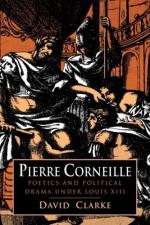|
This section contains 5,140 words (approx. 18 pages at 300 words per page) |

|
SOURCE: Reed, Gervais E. “Visual Imagery and Christian Humanism in Rodogune.” French Review 63, no. 3 (February 1990): 464-74.
In the following essay, Reed considers Corneille's emphasis on visual imagery and Christian theology in Rodogune.
Nearly 350 years after its first run in Paris, Pierre Corneille's Rodogune still stimulates critical discussion.1 For example, Jacques Scherer (xx) has argued that Rodogune represents Corneille's desire to return to the excitement of depicting horrible crimes like those of Médée, his first tragedy. Couton (II, 1283) echoes this judgment in his new edition of the playwright's complete works. Because the tragedy of ideas had run its course, Couton says, Corneille depoliticized this play as well as Théodore and Héraclius, and he did with all three tragedies what journalists do when news runs dry: he put crime on the front page. According to Serge Doubrovsky (292), violation of human nature became a new motif in...
|
This section contains 5,140 words (approx. 18 pages at 300 words per page) |

|


